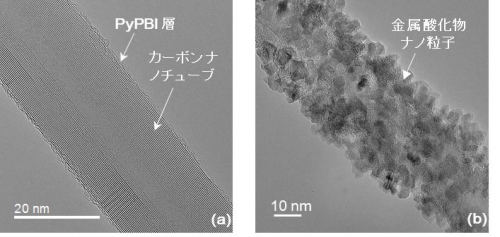研究成果 Research Results
- TOP
- News
- Research Results
- Development of High Performance Inorganic Metal Oxide Hybrid Catalysts Using Carbon Nanotubes
Development of High Performance Inorganic Metal Oxide Hybrid Catalysts Using Carbon Nanotubes
2017.03.30Research ResultsPhysics & ChemistryMaterials
The research group of Prof. Naotoshi Nakashima, Assoc. Prof. Tsuyohiko Fujigaya and Research Assist. Prof. Jun Yang at Kyushu University’s Graduate School of Engineering and the International Institute for Carbon-Neutral Energy Research (I2CNER) has successfully developed high performance inorganic metal oxide hybrid catalysts using carbon nanotubes.
Many inorganic metal oxides exhibit excellent catalytic activities for energy conversion reactions such as oxygen reduction reaction, oxygen evolution reaction, hydrogen evolution reaction, etc. However, in many cases, metal oxides cannot serve as good catalysts by themselves because they usually do not possess sufficient specific area and electrical conductivity. As a result, carbon nanotubes (CNTs), which have high electrical conductivity and large surface area are used as the support for the metal oxides. Pristine multi-walled carbon nanotubes (MWNTs) are in lack of binding sites on their surfaces. Therefore, the common method is to create defects on the surfaces of MWNTs using oxidizing treatment prior to hybridizing with metal oxides. Such a pretreatment will obviously damage the graphitic surface of the CNT and thus decreases their electrical conductivity and stability of the catalyst. In the present study, pristine MWNTs were wrapped by pyridine-based polybenzimidazole (PyPBI), in which uniform NixCo3-xO4 nanocrystals were homogeneously deposited by the solvothermal method(*1) without damaging the MWNTs for the first time. The obtained catalyst (MWNT-PyPBI-NixCo3-xO4) outperformed most state-of-the-art non-precious metal-based bifunctional catalysts. Additionally, this strategy for preparing the hybrid catalyst of NixCo3-xO4 and pristine MWNTs provides an easy scalability, and can be applicable to other transition metal oxides, for example, perovskites with high oxygen evolution reaction activity but low electrical conductivity. Such studies are currently being conducted in our laboratory.
This research achievement was published online in Scientific Reports on March 30, 2017, 10:00am (UK local time).

(Figure)SEM images of (a) MWNT-PyPBI and (b) MWNT-PyPBI-NixCo3-xO4.
Researcher comments
Carbon nanotubes, polymer, and inorganic metal oxides belong to very different scientific fields. When they are combined together, something new is created. That is why interdisciplinary studies are charming and important.
Journal Reference
Decorating unoxidized-carbon nanotubes with homogeneous Ni-Co spinel nanocrystals show superior performance for oxygen evolution/reduction reactions, ,Scientific Reports, 10.1038/srep45384Research-related inquiries
- TOP
- News
- Research Results
- Development of High Performance Inorganic Metal Oxide Hybrid Catalysts Using Carbon Nanotubes































